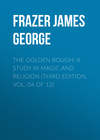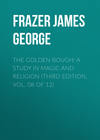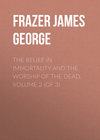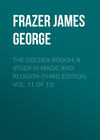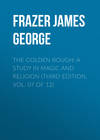Czytaj książkę: «The Golden Bough: A Study in Magic and Religion (Third Edition, Vol. 04 of 12)», strona 5
§ 4. Octennial Tenure of the Kingship
Limited tenure of the kingship in ancient Greece. The Spartan kings appear formerly to have held office for periods of eight years only. The dread of meteors shared by savages.
There are some grounds for believing that the reign of many ancient Greek kings was limited to eight years, or at least that at the end of every period of eight years a new consecration, a fresh outpouring of the divine grace, was regarded as necessary in order to enable them to discharge their civil and religious duties. Thus it was a rule of the Spartan constitution that every eighth year the ephors should choose a clear and moonless night and sitting down observe the sky in silence. If during their vigil they saw a meteor or shooting star, they inferred that the king had sinned against the deity, and they suspended him from his functions until the Delphic or Olympic oracle should reinstate him in them. This custom, which has all the air of great antiquity, was not suffered to remain a dead letter even in the last period of the Spartan monarchy; for in the third century before our era a king, who had rendered himself obnoxious to the reforming party, was actually deposed on various trumped-up charges, among which the allegation that the ominous sign had been seen in the sky took a prominent place.113 When we compare this custom with the evidence to be presently adduced of an eight years' tenure of the kingship in Greece, we shall probably agree with K. O. Müller114 that the quaint Spartan practice was much more than a mere antiquarian curiosity; it was the attenuated survival of an institution which may once have had great significance, and it throws an important light on the restrictions and limitations anciently imposed by religion on the Dorian kingship. What exactly was the import of a meteor in the opinion of the old Dorians we can hardly hope to determine; one thing only is clear, they regarded it as a portent of so ominous and threatening a kind that its appearance under certain circumstances justified and even required the deposition of their king. This exaggerated dread of so simple a natural phenomenon is shared by many savages at the present day; and we shall hardly err in supposing that the Spartans inherited it from their barbarous ancestors, who may have watched with consternation, on many a starry night among the woods of Germany, the flashing of a meteor through the sky. It may be well, even at the cost of a digression, to illustrate this primitive superstition by examples.
Superstitions of the Australian aborigines as to shooting stars.
Thus, shooting stars and meteors are viewed with apprehension by the natives of the Andaman Islands, who suppose them to be lighted faggots hurled into the air by the malignant spirit of the woods in order to ascertain the whereabouts of any unhappy wight in his vicinity. Hence if they happen to be away from their camp when the meteor is seen, they hide themselves and remain silent for a little before they venture to resume the work they were at; for example, if they are out fishing they will crouch at the bottom of the boat.115 The natives of the Tully River in Queensland believe falling stars to be the fire-sticks carried about by the spirits of dead enemies. When they see one shooting through the air they take it as a sign that an enemy is near, and accordingly they shout and make as much noise as they can; next morning they all go out in the direction in which the star fell and look for the tracks of their foe.116 The Turrbal tribe of Queensland thought that a falling star was a medicine-man flying through the air and dropping his fire-stick to kill somebody; if there was a sick man in the camp, they regarded him as doomed.117 The Ngarigo of New South Wales believed the fall of a meteor to betoken the place where their foes were mustering for war.118 The Kaitish tribe of central Australia imagine that the fall of a star marks the whereabouts of a man who has killed another by means of a magical pointing-stick or bone. If a member of any group has been killed in this way, his friends watch for the descent of a meteor, march in that direction, slay an enemy there, and leave his body lying on the ground. The friends of the murdered man understand what has happened, and bury his body where the star fell; for they recognise the spot by the softness of the earth.119 The Mara tribe of northern Australia suppose a falling star to be one of two hostile spirits, father and son, who live up in the sky and come down occasionally to do harm to men. In this tribe the profession of medicine-man is strictly hereditary in the stock which has the falling star for its totem;120 if these wizards had ever developed into kings, the descent of a meteor at certain times might have had the same fatal significance for them as for the kings of Sparta. The Taui Islanders, to the west of the Bismarck Archipelago, make war in the direction in which they have observed a star to fall,121 probably for a reason like that which induces the Kaitish to do the same.
Superstitions of the negroes and other African races as to shooting stars.
When the Baronga of south Africa see a shooting star they spit on the ground to avert the evil omen, and cry, “Go away! go away all alone!” By this they mean that the light, which is so soon to disappear, is not to take them with it, but to go and die by itself.122 So when a Masai perceives the flash of a meteor he spits several times and says, “Be lost! go in the direction of the enemy!” after which he adds, “Stay away from me.”123 The Namaquas “are greatly afraid of the meteor which is vulgarly called a falling star, for they consider it a sign that sickness is coming upon the cattle, and to escape it they will immediately drive them to some other parts of the country. They call out to the star how many cattle they have, and beg of it not to send sickness.”124 The Bechuanas are also much alarmed at the appearance of a meteor. If they happen to be dancing in the open air at the time, they will instantly desist and retire hastily to their huts.125 The Ewe negroes of Guinea regard a falling star as a powerful divinity, and worship it as one of their national gods, by the name of Nyikpla or Nyigbla. In their opinion the falling star is especially a war-god who marches at the head of the host and leads it to victory, riding like Castor and Pollux on horseback. But he is also a rain-god, and the showers are sent by him from the sky. Special priests are devoted to his worship, with a chief priest at their head, who resides in the capital. They are known by the red staves which they carry and by the high-pointed caps, woven of threads and palm-leaves, which they wear on their heads. In times of drought they call upon their god by night with wild howls. Once a year an ox is sacrificed to him at the capital, and the priests consume the flesh. On this occasion the people smear themselves with the pollen of a certain plant and go in procession through the towns and villages, singing, dancing, and beating drums.126
Superstitions of the American Indians as to shooting stars.
By some Indians of California meteors were called “children of the moon,” and whenever young women saw one of them they fell to the ground and covered their heads, fearing that, if the meteor saw them, their faces would become ugly and diseased.127 The Tarahumares of Mexico fancy that a shooting star is a dead sorcerer coming to harm a man who harmed him in life. Hence when they see one they huddle together and scream for terror.128 When a German traveller was living with the Bororos of central Brazil, a splendid meteor fell, spreading dismay through the Indian village. It was believed to be the soul of a dead medicine-man, who suddenly appeared in this form to announce that he wanted meat, and that, as a preliminary measure, he proposed to visit somebody with an attack of dysentery. Its appearance was greeted with yells from a hundred throats: men, women, and children swarmed out of their huts like ants whose nest has been disturbed; and soon watch-fires blazed, round which at a little distance groups of dusky figures gathered, while in the middle, thrown into strong relief by the flickering light of the fire, two red-painted sorcerers reeled and staggered in a state of frantic excitement, snorting and spitting towards the quarter of the sky where the meteor had run its brief but brilliant course. Pressing his right hand to his yelling mouth, each of them held aloft in his extended left, by way of propitiating the angry star, a bundle of cigarettes. “There!” they seemed to say, “all that tobacco will we give to ward off the impending visitation. Woe to you, if you do not leave us in peace.”129 The Lengua Indians of the Gran Chaco also stand in great fear of meteors, imagining them to be stones hurled from heaven at the wicked sorcerers who have done people to death by their charms.130 When the Abipones beheld a meteor flashing or heard thunder rolling in the sky, they imagined that one of their medicine-men had died, and that the flash of light and the peal of thunder were part of his funeral honours.131
Shooting stars regarded as demons.
When the Laughlan Islanders see a shooting star they make a great noise, for they think it is the old woman who lives in the moon coming down to earth to catch somebody, who may relieve her of her duties in the moon while she goes away to the happy spirit-land.132 In Vedic India a meteor was believed to be the embodiment of a demon, and on its appearance certain hymns or incantations, supposed to possess the power of killing demons, were recited for the purpose of expiating the prodigy.133 To this day in India, when women see a falling star, they spit thrice to scare the demon.134 Some of the Esthonians at the present time regard shooting stars as evil spirits.135 It is a Mohammedan belief that falling stars are demons or jinn who have attempted to scale the sky, and, being repulsed by the angels with stones, are hurled headlong, flaming, from the celestial vault. Hence every true believer at sight of a meteor should say, “I take refuge with God from the stoned devil.”136
Shooting stars associated with the souls of the dead. Supposed relation of the stars to men.
A widespread superstition, of which some examples have already been given, associates meteors or falling stars with the souls of the dead. Often they are believed to be the spirits of the departed on their way to the other world. The Maoris imagine that at death the soul leaves the body and goes to the nether world in the form of a falling star.137 The Kingsmill Islanders deemed a shooting star an omen of death to some member of the family which occupied the part of the council-house nearest to the point of the sky whence the meteor took its flight. If the star was followed by a train of light, it foretold the death of a woman; if not, the death of a man.138 When the Wotjobaluk tribe of Victoria see a shooting star, they think it is falling with the heart of a man who has been caught by a sorcerer and deprived of his fat.139 One evening when Mr. Howitt was talking with an Australian black, a bright meteor was seen shooting through the sky. The native watched it and remarked, “An old blackfellow has fallen down there.”140 Among the Yerrunthally tribe of Queensland the ideas on this subject were even more definite. They thought that after death they went to a place away among the stars, and that to reach it they had to climb up a rope; when they had clambered up they let go the rope, which, as it fell from heaven, appeared to people on earth as a falling star.141 The natives of the Prince of Wales Islands, off Queensland, are much afraid of shooting stars, for they believe them to be ghosts which, in breaking up, produce young ones of their own kind.142 The natives of the Gazelle Peninsula in New Britain think that meteors are the souls of people who have been murdered or eaten; so at the sight of a meteor flashing they cry out, “The ghost of a murdered man!”143 According to the Sulka of New Britain meteors are souls which have been flung into the air in order to plunge into the sea; and the train of light which they leave behind them is a burning tail of dry coco-nut leaves which has been tied to them by other souls, in order to help them to wing their way through the air.144 The Caffres of South Africa often say that a shooting star is the sign of the death of some chief, and at sight of it they will spit on the ground as a mark of friendly feeling towards the dead man.145 Similarly the Ababua of the Congo valley think that a chief will die in the village into which a star appears to fall, unless the danger of death be averted by a particular dance.146 In the opinion of the Masai, the fall of a meteor signifies the death of some one; at sight of it they pray that the victim may be one of their enemies.147 The Wambugwe of eastern Africa fancy that the stars are men, of whom one dies whenever a star is seen to fall.148 The Tinneh Indians and the Tchiglit Esquimaux of north-western America believe that human life on earth is influenced by the stars, and they take a shooting star to be a sign that some one has died.149 The Lolos, an aboriginal tribe of western China, hold that for each person on earth there is a corresponding star in the sky. Hence when a man is ill, they sacrifice wine to his star and light four and twenty lamps outside of his room. On the day after the funeral they dig a hole in the chamber of death and pray the dead man's star to descend and be buried in it. If this precaution were not taken, the star might fall and hit somebody and hurt him very much.150 In classical antiquity there was a popular notion that every human being had his own star in the sky, which shone bright or dim according to his good or evil fortune, and fell in the form of a meteor when he died.151
Modern European beliefs as to meteors. Various beliefs as to stars and meteors.
Superstitions of the same sort are still commonly to be met with in Europe. Thus in some parts of Germany they say that at the birth of a man a new star is set in the sky, and that as it burns brilliantly or faintly he grows rich or poor; finally when he dies it drops from the sky in the likeness of a shooting star.152 Similarly in Brittany, Transylvania, Bohemia, the Abruzzi, the Romagna, and the Esthonian island of Oesel it is thought by some that every man has his own particular star in the sky, and that when it falls in the shape of a meteor he expires.153 A like belief is entertained by Polish Jews.154 In Styria they say that when a shooting star is seen a man has just died, or a poor soul been released from purgatory.155 The Esthonians believe that if any one sees a falling star on New Year's night he will die or be visited by a serious illness that year.156 In Belgium and many parts of France the people suppose that a meteor is a soul which has just quitted the body, sometimes that it is specially the soul of an unbaptized infant or of some one who has died without absolution. At sight of it they say that you should cross yourself and pray, or that if you wish for something while the star is falling you will be sure to get it.157 Among the Vosges Mountains in the warm nights of July it is not uncommon to see whole showers of shooting stars. It is generally agreed that these stars are souls, but some difference of opinion exists as to whether they are souls just taking leave of earth, or tortured by the fires of purgatory, or on their passage from purgatory to heaven.158 The last and most cheering of these views is held by the French peasantry of Beauce and Perche and by the Italian peasantry of the Abruzzi, and charitable people pray for the deliverance of a soul at the sight of a falling star.159 The downward direction of its flight might naturally suggest a different goal; and accordingly other people have seen in the transient flame of a meteor the descent of a soul from heaven to be born on earth. In the Punjaub, for example, Hindoos believe that the length of a soul's residence in the realms of bliss is exactly proportioned to the sums which the man distributed in charity during his life; and that when these are exhausted his time in heaven is up, and down he comes.160 In Polynesia a shooting star was held to be the flight of a spirit, and to presage the birth of a great prince.161 The Mandans of north America fancied that the stars were dead people, and that when a woman was brought to bed a star fell from heaven, and entering into her was born as a child.162 On the Biloch frontier of the Punjaub each man is held to have his star, and he may not journey in particular directions when his star is in certain positions. If duty compels him to travel in the forbidden direction, he takes care before setting out to bury his star, or rather a figure of it cut out of cloth, so that it may not see what he is doing.163
The fall of the king's star.
Which, if any, of these superstitions moved the barbarous Dorians of old to depose their kings whenever at a certain season a meteor flamed in the sky, we cannot say. Perhaps they had a vague general notion that its appearance signified the dissatisfaction of the higher powers with the state of the commonwealth; and since in primitive society the king is commonly held responsible for all untoward events, whatever their origin, the natural course was to relieve him of duties which he had proved himself incapable of discharging. But it may be that the idea in the minds of these rude barbarians was more definite. Possibly, like some people in Europe at the present day, they thought that every man had his star in the sky, and that he must die when it fell. The king would be no exception to the rule, and on a certain night of a certain year, at the end of a cycle, it might be customary to watch the sky in order to mark whether the king's star was still in the ascendant or near its setting. The appearance of a meteor on such a night – of a star precipitated from the celestial vault – might prove for the king not merely a symbol but a sentence of death. It might be the warrant for his execution.
Reasons for limiting a king's reign to eight years. The octennial cycle based on an attempt to reconcile solar and lunar time.
If the tenure of the regal office was formerly limited among the Spartans to eight years, we may naturally ask, why was that precise period selected as the measure of a king's reign? The reason is probably to be found in those astronomical considerations which determined the early Greek calendar. The difficulty of reconciling lunar with solar time is one of the standing puzzles which has taxed the ingenuity of men who are emerging from barbarism. Now an octennial cycle is the shortest period at the end of which sun and moon really mark time together after overlapping, so to say, throughout the whole of the interval. Thus, for example, it is only once in every eight years that the full moon coincides with the longest or shortest day; and as this coincidence can be observed with the aid of a simple dial, the observation is naturally one of the first to furnish a base for a calendar which shall bring lunar and solar times into tolerable, though not exact, harmony.164 But in early days the proper adjustment of the calendar is a matter of religious concern, since on it depends a knowledge of the right seasons for propitiating the deities whose favour is indispensable to the welfare of the community.165 No wonder, therefore, that the king, as the chief priest of the state, or as himself a god, should be liable to deposition or death at the end of an astronomical period. When the great luminaries had run their course on high, and were about to renew the heavenly race, it might well be thought that the king should renew his divine energies, or prove them unabated, under pain of making room for a more vigorous successor. In southern India, as we have seen, the king's reign and life terminated with the revolution of the planet Jupiter round the sun. In Greece, on the other hand, the king's fate seems to have hung in the balance at the end of every eight years, ready to fly up and kick the beam as soon as the opposite scale was loaded with a falling star.
The octennial cycle in relation to the Greek doctrine of rebirth.
The same train of thought may explain an ancient Greek custom which appears to have required that a homicide should be banished his country, and do penance for a period of eight or nine years.166 With the beginning of a new cycle or great year, as it was called, it might be thought that all nature was regenerate, all old scores wiped out. According to Pindar, the dead whose guilt had been purged away by an abode of eight years in the nether world were born again on earth in the ninth year as glorious kings, athletes, and sages.167 The doctrine may well be an old popular belief rather than a mere poetical fancy. If so, it would supply a fresh reason for the banishment of a homicide during the years that the angry ghost of his victim might at any moment issue from its prison-house and pounce on him. Once the perturbed spirit had been happily reborn, he might be supposed to forgive, if not to forget, the man who had done him an injury in a former life.
The octennial cycle at Cnossus in Crete. King Minos and Zeus. Sacred marriage of the king and queen of Cnossus in the form of bull and cow as symbols of the sun and moon.
Whatever its origin may have been, the cycle of eight years appears to have coincided with the normal length of the king's reign in other parts of Greece besides Sparta. Thus Minos, king of Cnossus in Crete, whose great palace has been unearthed in recent years, is said to have held office for periods of eight years together. At the end of each period he retired for a season to the oracular cave on Mount Ida, and there communed with his divine father Zeus, giving him an account of his kingship in the years that were past, and receiving from him instructions for his guidance in those which were to come.168 The tradition plainly implies that at the end of every eight years the king's sacred powers needed to be renewed by intercourse with the godhead, and that without such a renewal he would have forfeited his right to the throne. We may surmise that among the solemn ceremonies which marked the beginning or the end of the eight years' cycle the sacred marriage of the king with the queen played an important part, and that in this marriage we have the true explanation of the strange legend of Pasiphae and the bull. It was said that Pasiphae, the wife of King Minos, fell in love with a wondrous white bull which rose from the sea, and that in order to gratify her unnatural passion the artist Daedalus constructed a hollow wooden cow, covered with a cow's hide, in which the love-sick queen was hidden while the bull mounted it. The result of their union was the Minotaur, a monster with the body of a man and the head of a bull, whom the king shut up in the labyrinth, a building full of such winding and intricate passages that the prisoner might roam in it for ever without finding the way out.169 The legend appears to reflect a mythical marriage of the sun and moon, which was acted as a solemn rite by the king and queen of Cnossus, wearing the masks of a bull and cow respectively.170 To a pastoral people a bull is the most natural type of vigorous reproductive energy,171 and as such is a fitting emblem of the sun. Islanders who, like many of the Cretans, see the sun daily rising from the sea, might readily compare him to a white bull issuing from the waves. Indeed, we are expressly told that the Cretans called the sun a bull.172 Similarly in ancient Egypt the sacred bull Mnevis of Heliopolis (the City of the Sun) was deemed an incarnation of the Sun-god,173 and for thousands of years the kings of Egypt delighted to be styled “mighty bull”; many of them inscribed the title on their serekh or cognisance, which set forth their names in their character of descendants of Horus.174 The identification of Pasiphae, “she who shines on all,” with the moon was made long ago by Pausanias, who saw her image along with that of the sun in a sanctuary on that wild rocky coast of Messenia where the great range of Taygetus descends seaward in a long line of naked crags.175 The horns of the waxing or waning moon naturally suggest the resemblance of the luminary to a white cow; hence the ancients represented the goddess of the moon drawn by a team of white cattle.176 When we remember that at the court of Egypt the king and queen figured as god and goddess in solemn masquerades, where the parts of animal-headed deities were played by masked men and women,177 we need have no difficulty in imagining that similar dramas may have been performed at the court of a Cretan king, whether we suppose them to have been imported from Egypt or to have had an independent origin.
The same myth and custom of the marriage of the sun and moon appear in the stories of Zeus and Europa, of Minos and Britomartis. The conjunction of the sun and moon regarded as the best time for marriages. Octennial marriage of the king and queen as representatives of the sun and moon.
The stories of Zeus and Europa, and of Minos and Britomartis or Dictynna appear to be only different expressions of the same myth, different echoes of the same custom. The moon rising from the sea was the fair maiden Europa coming across the heaving billows from the far eastern land of Phoenicia, borne or pursued by her suitor the solar bull. The moon setting in the western waves was the coy Britomartis or Dictynna, who plunged into the sea to escape the warm embrace of her lover Minos, himself the sun. The story how the drowning maiden was drawn up in a fisherman's net may well be, as some have thought, the explanation given by a simple seafaring folk of the moon's reappearance from the sea in the east after she had sunk into it in the west.178 To the mythical fancy of the ancients the moon was a coy or a wanton maiden, who either fled from or pursued the sun every month till the fugitive was overtaken and the lovers enjoyed each other's company at the time when the luminaries are in conjunction, namely, in the interval between the old and the new moon. Hence on the principles of sympathetic magic that interval was considered the time most favourable for human marriages. When the sun and moon are wedded in the sky, men and women should be wedded on earth. And for the same reason the ancients chose the interlunar day for the celebration of the Sacred Marriages of gods and goddesses. Similar beliefs and customs based on them have been noted among other peoples.179 It is likely, therefore, that a king and queen who represented the sun and moon may have been expected to exercise their conjugal rights above all at the time when the moon was thought to rest in the arms of the sun. However that may have been, it would be natural that their union should be consummated with unusual solemnity every eight years, when the two great luminaries, so to say, meet and mark time together once more after diverging from each other more or less throughout the interval. It is true that sun and moon are in conjunction once every month, but every month their conjunction takes place at a different point in the sky, until eight revolving years have brought them together again in the same heavenly bridal chamber where first they met.
Octennial tribute of youths and maidens probably required as a means of renewing the sun's fire by human sacrifices. The Minotaur a bull-headed image of the sun.
Without being unduly rash we may surmise that the tribute of seven youths and seven maidens whom the Athenians were bound to send to Minos every eight years had some connexion with the renewal of the king's power for another octennial cycle. Traditions varied as to the fate which awaited the lads and damsels on their arrival in Crete; but the common view appears to have been that they were shut up in the labyrinth, there to be devoured by the Minotaur, or at least to be imprisoned for life.180 Perhaps they were sacrificed by being roasted alive in a bronze image of a bull, or of a bull-headed man, in order to renew the strength of the king and of the sun, whom he personated. This at all events is suggested by the legend of Talos, a bronze man who clutched people to his breast and leaped with them into the fire, so that they were roasted alive. He is said to have been given by Zeus to Europa, or by Hephaestus to Minos, to guard the island of Crete, which he patrolled thrice daily.181 According to one account he was a bull,182 according to another he was the sun.183 Probably he was identical with the Minotaur, and stripped of his mythical features was nothing but a bronze image of the sun represented as a man with a bull's head. In order to renew the solar fires, human victims may have been sacrificed to the idol by being roasted in its hollow body or placed on its sloping hands and allowed to roll into a pit of fire. It was in the latter fashion that the Carthaginians sacrificed their offspring to Moloch. The children were laid on the hands of a calf-headed image of bronze, from which they slid into a fiery oven, while the people danced to the music of flutes and timbrels to drown the shrieks of the burning victims.184 The resemblance which the Cretan traditions bear to the Carthaginian practice suggests that the worship associated with the names of Minos and the Minotaur may have been powerfully influenced by that of a Semitic Baal.185 In the tradition of Phalaris, tyrant of Agrigentum, and his brazen bull186 we may have an echo of similar rites in Sicily, where the Carthaginian power struck deep roots.
Dance of the youths and maidens at Cnossus.
But perhaps the youths and maidens who were sent across the sea to Cnossus had to perform certain religious duties before they were cast into the fiery furnace. The same cunning artist Daedalus who planned the labyrinth and contrived the wooden cow for Pasiphae was said to have made a dance for Ariadne, daughter of Minos. It represented youths and maidens dancing in ranks, the youths armed with golden swords, the maidens crowned with garlands.187 Moreover, when Theseus landed with Ariadne in Delos on his return from Crete, he and the young companions whom he had rescued from the Minotaur are said to have danced a mazy dance in imitation of the intricate windings of the labyrinth; on account of its sinuous turns the dance was called “the Crane.”188 Taken together, these two traditions suggest that the youths and maidens who were sent to Cnossus had to dance in the labyrinth before they were sacrificed to the bull-headed image. At all events there are good grounds for thinking that there was a famous dance which the ancients regularly associated with the Cretan labyrinth.
with the Scholia; Plato, Laws, i. I. p. 624 a, b;[id.] Minos, 13 sq., pp. 319 sq.; Strabo, ix. 4. 8, p. 476; Maximus Tyrius, Dissert. xxxviii. 2; Etymologicum magnum, s. v. ἐννέωροι, p. 343, 23 sqq.; Valerius Maximus, i. 2, ext. I; compare Diodorus Siculus, v. 78. 3. Homer's expression, ἐννέωρος βασίλευε, has been variously explained. I follow the interpretation which appears to have generally found favour both with the ancients, including Plato, and with modern scholars. See K. Hoeck, Kreta, i. 244 sqq.; K. O. Müller,Die Dorier,2 ii. 96; G. F. Unger, “Zeitrechnung der Griechen und Römer,” in Ivan Müller's Handbuch der klassischen Altertumswissenschaft, i. 569; A. Schmidt, Handbuch der griechischen Chronologie (Jena, 1888), p. 65; W. H. Roscher, “Die enneadischen und hebdomadischen Fristen und Wochen der ältesten Griechen,” Abhandlungen der philolog. – histor. Klasse der Königl. Sächsischen Gesellschaft der Wissenschaften, xxi. No. 4 (Leipsic, 1903), pp. 22 sq.; E. Rohde, Psyche,3 i. 128 sq. Literally interpreted, ἐννέωρος means “for nine years,” not “for eight years.” But see above, p. 59, note 1.
